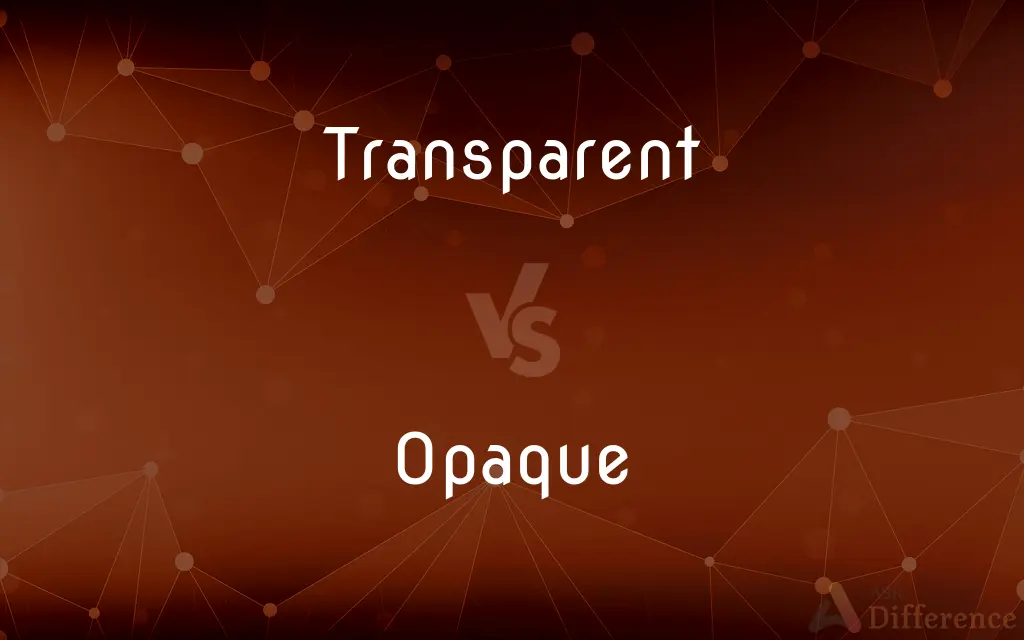Transparent vs. Opaque — What's the Difference?
By Maham Liaqat & Fiza Rafique — Updated on February 29, 2024
Transparent materials allow light to pass through with minimal distortion, enabling clear visibility of objects behind them, while opaque materials block light, preventing any visibility of objects through them.

Difference Between Transparent and Opaque
Table of Contents
ADVERTISEMENT
Key Differences
Transparent materials, such as clear glass or clean water, are characterized by their ability to let light waves pass through them almost unhindered. This property allows objects behind the transparent material to be seen clearly from the other side. The degree of transparency can vary, but the key aspect is that visibility through the material is preserved. Transparency is crucial in applications like windows, eyeglasses, and camera lenses, where clear vision or light transmission is necessary.
Opaque materials, on the other hand, do not allow light to pass through. Metals, wood, and stone are examples of opaque substances. When light hits an opaque object, it is either absorbed or reflected, but it does not pass through, making it impossible to see through the material. Opaqueness is essential for privacy, security, and in various design elements where visibility through a material is not desired.
The difference between transparent and opaque materials lies in their atomic and molecular structure, which dictates how they interact with light. Transparent materials have a structure that allows photons to pass through without significant scattering or absorption. In contrast, the structure of opaque materials does not permit light to pass through, leading to either absorption or reflection of light.
In some cases, materials can exhibit properties of both transparency and opacity under different conditions or when treated with certain coatings or processes. For example, frosted glass is made by etching the surface of clear glass, scattering light and making it translucent, a state between transparent and opaque where light passes through but without clear visibility of objects.
Understanding the properties of transparent and opaque materials is crucial in a wide range of scientific, architectural, and artistic fields. It affects decisions in design, functionality, and the aesthetic aspects of materials used in various applications.
ADVERTISEMENT
Comparison Chart
Light Transmission
Allows light to pass through clearly
Blocks light from passing through
Visibility Through Material
High visibility of objects behind
No visibility of objects behind
Examples
Glass, clear plastics, clean water
Metals, wood, stone
Applications
Windows, eyeglasses, camera lenses
Walls, doors, non-transparent containers
Material Structure
Atomic structure allows light to pass with minimal distortion
Atomic structure blocks or absorbs light
Compare with Definitions
Transparent
Transparent materials let light pass through, allowing clear sight of objects behind.
A transparent glass window allows people to see outside.
Opaque
Opaque materials prevent light from passing through, blocking visibility.
A wooden door is opaque, providing privacy.
Transparent
They are used where visibility is crucial.
Car windshields are made of transparent materials for safe driving.
Opaque
They are chosen for their light-blocking properties.
Metal panels are used in construction for their opaque quality.
Transparent
Transparent materials can vary in thickness while maintaining clarity.
Aquarium tanks are made of thick, transparent glass.
Opaque
Opaque materials are used in packaging to protect contents from light.
Aluminum cans are opaque, preserving the beverage inside from sunlight.
Transparent
They do not alter the color of light passing through.
A colorless transparent film is used on smartphone screens.
Opaque
Opacity is important in creating visual barriers.
Privacy fences are made from opaque materials to block visibility from outside.
Transparent
Transparency is a key feature in optical devices.
Camera lenses are made from transparent optical glass for clear imaging.
Opaque
They can reflect or absorb light without transmission.
A black opaque surface absorbs most of the light that hits it.
Transparent
Capable of transmitting light so that objects or images can be seen as if there were no intervening material.
Opaque
Impenetrable by light; neither transparent nor translucent.
Transparent
Permeable to electromagnetic radiation of specified frequencies, as to visible light or radio waves.
Opaque
Not reflecting light; having no luster
An opaque finish.
Transparent
Easily seen through or detected; obvious
Transparent lies.
Opaque
Impenetrable by a form of radiant energy other than visible light
A chemical solution opaque to x-rays.
Transparent
(of a material or object) See-through, clear; having the property that light passes through it almost undisturbed, such that one can see through it clearly.
The waters of the lake were transparent until the factory dumped waste there.
Opaque
Something that is opaque, especially an opaque pigment used to darken parts of a photographic print or negative.
Transparent
Obvious; readily apparent; easy to see or understand.
His reasons for the decision were transparent.
I love playing poker with Steve, because he's so transparent.
Opaque
Allowing little light to pass through, not translucent or transparent.
Transparent
(signal processing) Having the property of transparency, i.e. sufficiently accurate that the compressed result is perceptually indistinguishable from the uncompressed input.
Opaque
Something which is opaque rather than translucent.
Transparent
Having the property of transmitting rays of light, so that bodies can be distinctly seen through; pervious to light; diaphanous; pellucid; as, transparent glass; a transparent diamond; - opposed to opaque.
Opaque
Impervious to the rays of light; not transparent; as, an opaque substance.
Transparent
Admitting the passage of light; open; porous; as, a transparent veil.
Opaque
That which is opaque; opacity.
Transparent
Easily understood or seen through (because of a lack of subtlety);
A transparent explanation
A transparent lie
Opaque
Not clear; not transmitting or reflecting light or radiant energy;
Opaque windows of the jail
Opaque to X-rays
Common Curiosities
How does thickness affect the transparency of a material?
While thickness can affect light transmission, truly transparent materials maintain clarity regardless of thickness, unlike translucent materials where thickness can diffuse light.
Can a material be both transparent and opaque?
Some materials can exhibit both properties under different conditions, but generally, materials are either transparent or opaque in a given state.
What makes a material transparent?
A material's transparency depends on its atomic structure, which allows light to pass through with minimal distortion.
Is water always transparent?
Clean water is transparent, but impurities, depth, and certain physical conditions can affect its transparency.
Why are some plastics transparent while others are opaque?
The transparency or opacity of plastics depends on their chemical composition and the manufacturing process, which determine how they interact with light.
Why is glass transparent?
Glass is transparent because its atomic structure does not significantly scatter or absorb visible light, allowing it to pass through almost unhindered.
Can transparency be considered a safety feature?
Yes, in contexts like vehicle windows or protective eyewear, transparency is crucial for visibility and safety.
Why are some gemstones transparent while others are opaque?
The transparency or opacity of gemstones depends on their crystal structure and the presence of impurities, affecting how light interacts with the material.
Can opacity be altered in materials?
Yes, the opacity of materials can be altered through treatments, coatings, or changes in physical conditions (e.g., temperature).
What is the difference between transparent and translucent?
Transparent materials allow clear visibility through them, while translucent materials allow light to pass but diffuse it, preventing clear visibility.
Are all metals opaque?
Yes, most metals are inherently opaque because their free electrons absorb and reflect light, preventing it from passing through.
How do opaque materials affect light?
Opaque materials either absorb or reflect light, preventing it from passing through, which is why you cannot see through them.
How is opacity controlled in manufacturing processes?
Opacity can be controlled through the selection of raw materials, the addition of opacifiers, or specific processing techniques.
What is the significance of opacity in privacy applications?
Opacity is crucial for privacy in applications like fencing, walls, and certain types of clothing, preventing visibility through the material.
What role does transparency play in architecture?
In architecture, transparency is used to create spaces filled with natural light, enhance visibility, and improve aesthetic appeal.
Share Your Discovery

Previous Comparison
Fortune vs. Misfortune
Next Comparison
Wherever vs. WhereAuthor Spotlight
Written by
Maham LiaqatCo-written by
Fiza RafiqueFiza Rafique is a skilled content writer at AskDifference.com, where she meticulously refines and enhances written pieces. Drawing from her vast editorial expertise, Fiza ensures clarity, accuracy, and precision in every article. Passionate about language, she continually seeks to elevate the quality of content for readers worldwide.














































